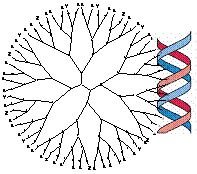|
LABORATORY for NANOMATERIALS of ORGANIZED SUPRAMOLECULAR STRUCTURE
Research Director
Dr. D. Tsiourvas,, Tel: +30
210 6503616, Fax: +30 210 6529792
e-mail: tsiourvas@chem.demokritos.gr
Permanent Staff
Dr.
Z. Sideratou, Researcher
Dr. M. Arkas
Post Doctors
Dr. A. Tziveleka
Collaborating Scientists
Dr. C. M. Paleos
Dr. Theodossis Theodossiou
Graduate Students
Ms. M. Galanou
Ms. N. Sterioti
The paper
entitled:“Molecular Engineering of Dendritic Polymers and Their Application
as Drug and Gene Delivery Systems
Paleos, C. M.; Tsiourvas, D.; Sideratou, Z.
Molecular Pharmaceutics; (Review); 2007; 4(2); 169-188. DOI:
10.1021/mp060076n”
is the third most accessed article of the journal.
Research
Activities
1.
Molecular Recognition of Liposomes -
Multifunctional Liposomes as Drug Delivery Systems.
Liposomes bearing recognizable groups are
employed in
molecular
recognition experiments with complementary liposomes or simple molecules in an
attempt to simulate the behaviour of cells. The external surface of liposomes is
modified with appropriate moieties for conducting the molecular recognition
experiments with the final objective to develop efficient drug delivery systems
combining stability, targeting and transporting properties,
Scheme 1.

Scheme 1 Scheme 2
2.
Multifunctional Dendrimeric and Hyperbranched Polymers (Dendritic
Polymers) as Drug and Gene Delivery Systems.
Multifunctionalization of dendritic polymers is conducted aiming at developing
drug and gene delivery systems exhibiting enhanced targeting, stability and
transport properties through cell membranes,
Scheme
2. Active drug ingredients are
incorporated in the nanocavities of dendritic polymers, while DNA forms
complexes with
positively charged dendritic polymers as shown in Scheme 3.

Scheme
3
3.
Dendritic
Polymers with Application in the Production of Ultrapure Water.
Alkylated dendritic polymers have the property of behaving as "nanosponges", in
the cavities of which hydrophobic water impurities are encapsulated (Scheme 4).
Ultrapure water is produced, in which the remaining
impurities are at the ppb level. Furthermore, cross-linked hydrophobic
dendrimeric and hyperbranched polymers have been developed for water
purification. Work has
also
been performed for the preparation of Organosilicon Dendrimers which were
applied at the surface of ceramic filters
for the production of ultrapure water.

4.
Development of Novel Thermotropic Liquid Crystals.
Novel liquid crystals are prepared through covalent and non-covalent synthesis.
Specifically ionic, or amphiphilic-type hydrogen-bonded thermotropic liquid
crystals with broad temperature range
have been prepared and characterized.

Research Facilities
The main research facilities available at
Laboratory and the “Institute of Physical Chemistry” include: Optical
Microscopes equipped with Image Analysis and Processing facilities, Atomic Force
and Scanning Tunneling Microscope, Thermal Analysis Facilities (DSC, TGA), Fluorescence, NMR and FT-IR spectrometers, Dynamic Light Scattering, z-potential
system and X-ray Diffraction Units.
Selected Publications |